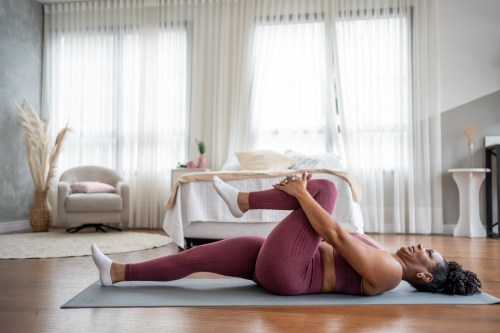Why It’s Critical To Give Your Body Proper Muscle Recovery Time In Order To Get Stronger
Sports medicine pros agree that giving yuor body proper muscle recovery time is one of the *most* important elements for getting stronger.

If the recovery boom of the last few years has taught us anything, it’s that your rest days are just as important as your active ones. Giving yourself proper muscle recovery time is critical for getting stronger and avoiding injury.
Chances are, you’ve experienced the hell that is second day soreness. And while it may be tempting to power through, you’re ultimately cheating yourself by forcing your muscles to make it through a workout that they’re not ready to do. According to pros, the days you spend out of the gym have almost as big of an impact on your fitness levels as the ones you spend in it. So if you’ve ever needed an excuse to take a rest day, consider this your full permission. Read on to find out why.
Why do muscles need to recover?
Any time you work out, you’re creating tiny “micro tears” within your muscles. When those tears repair themselves, it’s what makes your muscles stronger. But if you’re not giving those tears time to rebuild, by resting, that’s when you could start to run into problems. “In the scenario where the muscle does not have time to recover, a catabolic process occurs where the muscles degrade and continually break down,” says Austin Martinez, MS, CSCS, ATC, director of education for StretchLab. “This process is referred to as ‘overtraining.’ When this happens, your cortisol levels become elevated, which causes stress, adrenal fatigue, and muscle breakdown.”
Aside from the microtears, there are also chemical processes happening in your muscles during your workout that need time to reset. “You’re depleting the glycogen, which is the energy inside of the muscle, and in order to replenish the glycogen to perform at that level again you must give your muscle the time it needs to do so,” says regenerative sports medicine doctor Rand McClain, MD. “The build-up of certain types of acid within the muscle cell can result in failure of the muscle cell to perform but also cause some chemical (acid) damage that needs time to repair.” So before you hit the gym again, you’ll want to give all of these things ample time to reset.
How much muscle recovery time do you actually need?
The short answer is: It depends. “The time it takes for a muscle to recover is dependent upon the intensity and the load placed upon the muscle—and it includes both the amount of energy required in a burst, as well as the total amount of energy required in the entire workout,” says Dr. McClain. Things like age, fitness level, nutrition, sleep, and stress also come into play. “Using bigger muscles can take a bigger toll on the entire body and may require more rest between bouts of exercise.”
Longer, less intense “endurance” workouts require a different type of recovery than shorter, high-intensity ones. Generally, Dr. McClain recommends 24 hours of rest between weight training and other high-intensity workouts, while you may be able to get away with doing a few days of lower impact workouts in a row. “Overall, ‘load’—which includes the overall output generally quantified by the number of calories expended—also determines the amount of rest needed between exercise bouts,” says Dr. McClain, adding that this can differ based on your fitness levels.
Another thing to keep in mind is how much muscle recovery time your body needs during your workout, particularly when you’re doing HIIT training. If you’re looking improve your endurance, Martinez recommends low rest time (less than 20 seconds). If you’re looking to grow your muscles, he suggests allowing for 30 to 90 seconds between sets to allow for more ATP energy regeneration. And if you’re looking to build strength, he says you should rest for three minutes to allow for maximum energy regeneration to fuel your workout.
Is it okay to work out when you’re sore?
Usually, second-day soreness is a good indication that it’s time to take a day off. But depending on where you are in your fitness journey (like when you’re just starting out, or if you’re training for something particularly grueling) that isn’t always possible. “Some level of soreness often has to be ‘worked though,’ and, in fact, the concept of active recovery is one that uses low level exercise to speed the recovery from prior bouts of higher intensity and greater load workouts,” says Dr. McClain. If you’re questioning whether or not you’re too sore to hit the gym, pros recommend asking yourself four key questions: “Is anything swelling up?” “Do I have motion in all of my joints?” “Are certain parts of my body compensating for others?” and “Am I emotionally down for this workout?” If the answer to any of these is yes, you’re better off skipping the gym to give your body the time it needs to recover.
“The concept of ‘No Pain, No Gain’ has long ago been replaced by ‘No Brain, No Gain,'” says Dr. McClain. “The idea before was that if you trained to the point of muscle soreness, you were certain to have trained hard enough to stimulate an improvement in muscle fitness. However, we know now that in order to stimulate improved muscle fitness, one does not have to reach the point of muscle soreness.”
Is there any way to speed up muscle recover time?
You don’t have to remain totally inactive on rest days, however, unless you want to. You can use the time productively to help speed along your muscles’ recovery process. “Stretching is typically a good idea if there is no muscle injury or excessive inflammation, and foam rolling, percussion, hot and cold therapies each have their place in muscle recovery,” says Martinez. “But nutrition and rest—aka doing absolutely nothing—both hold essential places in recovery too.”
If you want to speed up muscle recovery time before you even leave the gym, working some recovery elements into your post-workout routine can also help to provide relief later on. “Adding stretching and foam rolling into your post-workout regimen can be very helpful in preventing muscle soreness, injury, and improving your performance during your workouts,” says Martinez. He suggests targeting the areas that you’ve worked—so, for example, on leg day you should be stretching your hamstrings, quadriceps, glutes, and calves—for best results.
Need some recovery inspo? Follow along with the video below.
Sign Up for Our Daily Newsletter
Get all the latest in wellness, trends, food, fitness, beauty, and more delivered right to your inbox.
Got it, you've been added to our email list.










